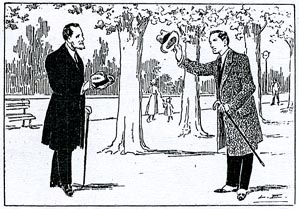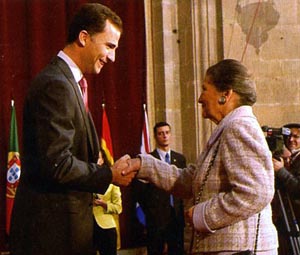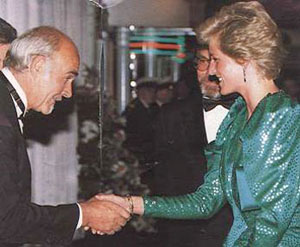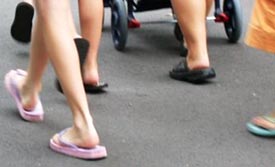 |
Formation of Children
The Art of Governing the Hands and Feet
Marian T. Horvat, Ph.D.
It seems to me that this chapter IX of The Small Manual of Civility on how the movements of a man’s hands and feet reflect his feeling and thinking is very important for our days. Instead of following time-honored norms of behavior, today’s youth is encouraged to show spontaneous feelings.
Instead of a greeting proportional to the degree of proximity or friendship, nowadays we see an empty, equalitarian handshake given to everyone everywhere. Also, the hug that used to be reserved for family and some rare occasions, today has become an empty universal sign. Even more, it is common to see young men hugging young women who are only casual school friends, or office colleagues giving each other hugs with a liberty that, to say the least, does not invite to virtue. This breaks the natural, healthy reserve that should exist between the sexes.
Our behavior of the hands and feet also leaves much room for improvement. It ignores the good customs of Catholic society, which advise that different persons should be treated in different ways. Do you want to be truly counter-revolutionary and build a Catholic civilization? Let us learn how to govern our hands and feet while in the company of others.
Here is my translation of the chapter of The Small Manual of Civility that deals with this much-neglected topic.
The relationship that exists between the physical and the moral in man is so strict and so deep that the sentiments and even the thinking of a man are usually translated exteriorly by a movement, a gesture, an action, be it voluntary or involuntary.
This is one reason we should learn to dominate our sentiments, subjecting them to a rule of behavior that is attentive to the persons with whom we deal. Likewise, we should be vigilant over our thoughts and repress every principle of disorder and intemperance.

Greeting a superior in the street in times past: Take off your hat some five or six steps from the meeting, look pleasantly at the person, incline forward slightly according to the hierarchy, raise the hand in a sign of greeting, not showing the interior of the hat. After passing, return the hat to the head |
The proper ways, gestures and actions that are the natural expression of interior peace and serenity of our soul disappear rapidly when the winds of passion invade and perturb our spirit. Our gestures and movements then reveal disquiet, agitation, or contrariety.
To avoid these rough sentiments from revealing themselves in our social relationship, we should develop the art of governing ourselves.
But rather than just appear to be good, it is better to really be good. Certainly, if you are dealing with a person who is well bred, he will discern your dissimulation. To pretend to be what you are not is a supreme fatuity. In order to present yourself as a good man, nothing is better than to be good.
Since a man’s gestures and actions suggest his thinking, the best way to have polite and elegant gestures is to have noble and elevated thoughts.
The most efficacious way to develop actions that have dignity and beauty in a child or adolescent is to put him in contact only with what is good, just, dignified, pure, beautiful and elevated. It is the same tactic of artists. For example, a music master cultivates and purifies the taste of his disciple, allowing him to hear only select pieces of good taste, executed by well tuned instruments.
Sentiments translate into gestures
The great influence that the exterior habits of the body have on the state of soul obliges us to severely watch over ourselves in our social relations. With regard to how we place our arms, let us observe the following rules:
- Avoid raising the arms over the head, making circles in the air or any such thing;
- Avoid crossing them behind the neck or on top of the head or behind the shoulders;
- Do not elbow your way through a crowd.
Various regular positions are:
- Both arms hanging naturally, without rigidity;
- One hanging and the other half bent;
- One on top of the other about the height of the waist;
- Arms crossed at chest height
No one, above all in company, should yawn loudly, accompanying this act with a ridiculous extension of the arms and spasmodic contortions of the body.
In normal conversations, words do not need the support of grand gestures; this same rule should be observed when directing oneself to a superior. Large gestures of the arms and hands, as props for our thinking, are normally admitted in public speeches. In private discussions, simple hand gestures are sufficient.
The hands reflect a man’s good customs
Hands should be washed not just upon rising, but also before meals and each time they touch something crass or dirty, or even simply suspicious. They should be dried with the towel destined for this service. Children, the ill-bred, and hillbillies easily violate this rule.
In company, it is not permitted to noisily rub the hands together, be it as a sign of satisfaction or to warm them.

Inappropriate hugging and touching has become common among today's youth |
Some ill-mannered persons use their hands too much: they take hold of the clothing or arm of the person they are speaking to, they pull at the curtains in the living room, they tap on the table; they finger objects within their reach; they pick off flowers in the gardens, they point from a distance at other persons. These ways are contrary to a well bred man.
Hand play, that is, playing with this or that person, trying to catch or touch one another, should be avoided rigorously; it is a sign of excessive familiarity, it generates disrespect for the person of the neighbor, it awakens sensuality and the lower passions.
Also, only someone who is poorly raised takes the liberty of cracking his fingers or putting them in the mouth, ears, or nostrils.
It would be unpardonable, being in company, to scratch the head, the neck, the chest, the legs or any other part of the body. Anyone who would witness this would imagine that the scratcher has fleas or lice or has some skin or scalp disease. Anyone who lives cleanly and wears fresh clothing does not need to scratch himself.
That fingernails should be clean is primary. They should be neither very short nor very long. Also, they should never be clipped in the company of others. One should flee the detestable habit of certain persons who allow the nail of the little finger to grow long; this is highly uncivil and repugnant, not only at the table but also in the handshake and at work. Employers of good sense do not have confidence in business applicants with long nails. Not only do they look like the talons of fighting roosters, they are also a sign of great vanity, pretension and foolishness.
Let fathers and teachers curb the bad habit that some boys have of biting their nails. In addition to being foul and vulgar, it is very bad for the health. Who knows what dirt and germs have gathered under the nails? Certainly such filth should not go in the mouth or be ingested.
The handshake

The lady makes the first gesture of offering her hand
 |
The handshake makes up part of the greeting, and as such is a complement to the personality. One should extend his hand only to persons he knows, to persons being presented by a friend, or to someone to whom he wants to give a spontaneous proof of confidence.
In the greeting of ladies, the man does not take the initiative in this gesture. The lady is the one who makes the first gesture of offering her hand, and the man should respond, because on the part of a lady this gesture is an indication of confidence. For the same reason, the hand is not extended to a superior: the superior is the one who first presents his hand, and in fact should do so.
In our Western culture, the man extends the right hand. If it is occupied, the objects should be passed to the other hand. In an exceptional case, the left hand can be presented, with a few words asking pardon for the irregularity.
One should offer the entire hand, in its full length, and not just several fingers, which would be quite impertinent. The open hand should be offered in a firm, straightforward manner; the hand should not be hard and tense. It would be bad taste and overly delicate for a man to just lightly touch the hand offered him.
One should not try to retain the hand of the person with whom one is speaking; if it is the hand of a lady, to keep hold of it would be an unpardonable lack of courtesy.
Offering one’s hand to superiors should be made naturally and with simplicity, with a slight inclination of the head, the legs and heels together, the left arm held in a natural position.
The need for shoes and socks
Civility prescribes certain rules regarding the legs and feet. We will not return to the topic, since it was already treated in a preceding chapter.
To walk barefoot is not acceptable. It would be uncomfortable in cold climates; in warm climates it is a means of contact with all the dirt and vermin that proliferate in the ground. In humid climates it can even be the cause for catching colds or more grave sicknesses.
A man has need of shoes just as he does of clothing, in this he differs from the animal. Socks should also be worn with shoes. The abundant sweating of the feet is absorbed by the cotton or silk material of the socks, which have this important hygienic function. Therefore, in the name of hygiene and good social behavior, a man should wear the stocking appropriate to the place and social condition of each person.
Shoes should be carefully preserved. Frequent care will increase the lives of dress shoes. In the city and in general society, shoes should be polished and have a good luster; in the countryside there is no such need. A man dressed elegantly who lacks a well-shined shoe seems like a salon with luxurious walls and a dirty floor.

A common sight in public places today: footwear that should be reserved for the beach or bath |
Shoes should fit the various occasions and occupations.
I might note that today we are assuming the revolutionary custom of wearing sports or beach shoes at home, at school, and in other public places. Everywhere today we see persons of all ages – even older men - wearing thongs and tennis shoes as part of their everyday dress. They do not seem to realize how unseemly this appears. It also sets a very bad example for the youth, who are given the idea that relaxation and comfort is the supreme rule of society.
We have compassion on poor persons obliged to go barefoot; they not only are exposed to many physical accidents, but also they find themselves lowered to imitate the animals that were created to walk on feet without shoes.

Posted February 20, 2007


Related Topics of Interest
 The Importance of the Greeting The Importance of the Greeting
 Chapter 8: The Smile, The Laugh, The Grimace Chapter 8: The Smile, The Laugh, The Grimace
 Chapter 7: Cleanliness and Good Hygiene Chapter 7: Cleanliness and Good Hygiene
 Chapter 6: The Eyes and the Gaze Chapter 6: The Eyes and the Gaze
 Chapter 5: Order in the Professional Life Chapter 5: Order in the Professional Life
 Chapter 4: Order and the Spirit of Order Chapter 4: Order and the Spirit of Order
 Chapter 3: How to Sit, Stand, Walk Chapter 3: How to Sit, Stand, Walk
 Chapter 2: Bearing Chapter 2: Bearing
 Introduction and Chapter 1 Introduction and Chapter 1
 Four Ways to Discern a Man's Soul by His Appearance Four Ways to Discern a Man's Soul by His Appearance

Related Works of Interest
|
|
Formation | Cultural |
Home | Books | CDs
| Search | Contact Us
| Donate

© 2002- Tradition in Action, Inc. All Rights Reserved
|
 |
|